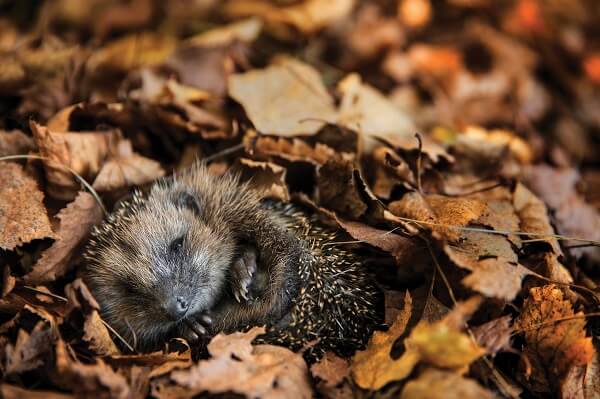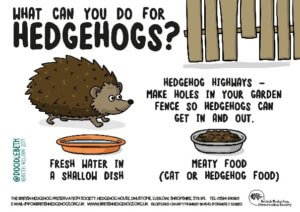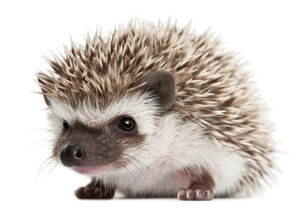Save Our Hedgehogs

Our native hedgehogs are on the decline. Here’s what you can do to help
According to the People’s Trust for Endangered Species (PTES), the number of hedgehogs in the UK has declined by a third since the millennium alone.
So why is it happening and how can we stop the decline?
We spoke to Fay Vass, Chief Executive of the British Hedgehog Preservation Society, to find out the best ways of helping our prickly little friends.
‘Hedgehog numbers have declined by a third in urban areas and a half in rural ones since the year 2000,’ she explains. ‘This is largely due to loss and fragmentation of habitat. While pockets of land may be good for hedgehogs, if they don’t join up with other pockets, the population won’t be sustainable. A hedgehog frequently travels around a mile in a night – that’s a lot of gardens!
‘Hedgehogs are generalist species, so the fact that they are declining so rapidly should ring loud alarm bells for us all. They are an excellent indicator species and their decline tells us that, very sadly, all is not well with the natural world.’
A helping hand
 There are lots of ways we can help hedgehogs survive, although if you can only do one thing, then make sure they can get from your garden into another one by cutting a CD-sized hole in the fence. ‘There’s no point making hedgehog-friendly gardens if they can’t get in,’ explains Fay. ‘Connecting gardens will open up a huge amout of space for them, so ask neighbours to do the same and log new holes on the Big Hedgehog Map at www.bighedgehogmap.org’
There are lots of ways we can help hedgehogs survive, although if you can only do one thing, then make sure they can get from your garden into another one by cutting a CD-sized hole in the fence. ‘There’s no point making hedgehog-friendly gardens if they can’t get in,’ explains Fay. ‘Connecting gardens will open up a huge amout of space for them, so ask neighbours to do the same and log new holes on the Big Hedgehog Map at www.bighedgehogmap.org’
Here are some other ideas to help our prickly friends.
 Keep a corner of your garden wild, or build a log pile to offer shelter, protection and natural food.
Keep a corner of your garden wild, or build a log pile to offer shelter, protection and natural food.- Avoid pesticides and slug pellets, as they can harm hedgehogs and damage their food chain. Try organic methods such as a ‘beer trap’, a small pot filled with beer and sunk in the ground, or the skin of half a grapefruit placed upside down to attract slugs. Protect plants with crushed egg shells or sharp sand around the base.
- Provide a shallow dish of fresh water and food, such as meat-based pet food or cat biscuits, especially during long, dry spells. Prevent cats from stealing the food by creating a hedgehog feeding station. Use a blue plastic mushroom box, or waterproof storage box, and cut a 13cm x 13cm (5” x 5”) hole in one of the short sides so that when the box is upside down the hole forms an entrance. Weight it down with a brick and put the food at the back. If necessary, place another brick about 13cm (5”) away from the entrance to stop cats lying down and reaching in with their paws.
- Make or buy a hedgehog home to offer a hibernation site safe from predators in the winter. It may also be used as a nesting box for a mother and her hoglets in the warmer months. The hoglets stay in the nest for four weeks after they are born. After that you will see them out of the nest with mum for a further four weeks, then at eight weeks old they are fully weaned and will wander off to find nest sites of their own. For more information send an A5 SAE to The British Hedgehog Preservation Society at Hedgehog House, Dhustone, Ludlow, SY8 3PL.
- Check areas for hedgehogs before strimming or mowing. Keep pea netting 22-30cm (9-12”) off the ground so hedgehogs can pass under, and start a compost heap; birds will feed off the mini-beasts that congregate there, as will hedgehogs and toads. A word of warning though before using the compost – test the base and sides gently for sleeping wildlife.
- Dispose of litter responsibly. Every year hedgehogs are injured by litter and starve to death by getting their heads trapped in discarded rubbish – empty food cans, yoghurt pots, plastic mugs. Worst are the plastic rings
that hold cans together. Always make sure each circle is cut. - Bonfires offer a tempting home for a hedgehog. Ideally, relocate materials just before the fire is to be lit. If this isn’t possible, lift the base with a pole to check for wildlife before lighting. Single hedgehogs can be moved – wear gardening gloves to pick the hedgehog up and pop it into a box, and release it when the fire has cooled. If
you come across a nest with babies in it, quietly put the materials back and leave well alone. Keep an eye on the site as the mother may abandon or even kill young if a nest is disturbed. If it seems the mother is not returning to the nest call the British Hedgehog Preservation Society helpline on 01584 890 801. - Hedgehogs are good swimmers but can become trapped in ponds or pools with steep slippery sides. Keep water levels topped up, provide a gently sloping edge or place half submerged rocks in the water as an escape.
For more information, go to the website for the British Hedgehog Preservation Society at www.britishhedgehogs.org.uk.

